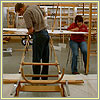

|
|
Wright Experience team members work on the "canard" of their 1902 glider in Ken
Hyde's workshop. The canard, from the French word for "duck" because it
resembles the shape of a duck's neck, is the elevator mechanism located at the
front of the aircraft. The curved wooden hip cradle, used for steering the
glider, appears in the foreground.
|
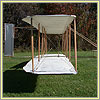

|
|
The 1902 Wright Glider, first flown on October 8, 1902, at Kitty Hawk and
reconstructed here, was the first Wright flying machine to look more like an
aircraft than a kite, as all their boxy earlier flying machines had. It was
also the first flying machine to perform the three functions all aircraft
perform today, from single-engine planes to spacecraft: roll, pitch,
and yaw.
|
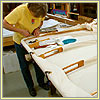

|
|
Beverly Hyde, wife of Ken Hyde, attaches the fabric wing skin to the outer wing
panel of the 1911 Model B reconstruction plane. The fabric seen here, like the
Wrights' Model B fabric, is rubberized and waterproof, which prevents the wings
from absorbing moisture and shrinking. In order to allow the plane's wings to
warp, or twist, while turning without ripping their fabric covering apart, the
wing skin is sewn together along diagonal lines.
|
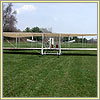

|
|
The Model B's fabric wings not only provided the surface area for airflow to
generate lift, they were also the centerpieces of the Wrights' wing-warping
system. Wing-warping took advantage of the twisting motion of the flexible
wings to make turns. In this photograph, the Wright Model B reconstruction
plane has its wings completely warped for making a turn to the left. That is, the
wings on the plane's right side (from the pilot's perspective) have warped
two feet downward towards the grass from their resting position, while
the wings on the plane's left side have warped upward.
|
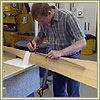

|
|
Dave Meyer takes minute measurements of the reconstruction 1911 Wright Model
B's distinctive "bent end" propeller, which is made of spruce. The bent-end
propeller was the Wrights' standard propeller from 1905 until 1915. It has an
efficiency rate of 80 percent, meaning that it can convert 80 percent of an
aircraft's engine power into useful thrust. Even with all the aviation
innovations since the Wrights, today's propellers have efficiency rates of
about 85 percent, only a slight improvement on the Wrights' remarkably advanced
design.
|
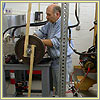

|
|
Greg Cone labors over the Wright Experience's reproduction of the 1903 Wright
engine, the prototype for the roughly 200 engines the Wrights built in total.
The four-cylinder engine had no throttle and could only run at full speed. In
the foreground, an original four-cylinder
1912 Model B engine stands by. This was the only engine the Wrights licensed
for production by other companies.
|
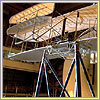

|
|
Here, the Wright Experience's 1903 Wright Flyer reproduction stands inside the
NASA Langley Full Scale Wind Tunnel in Hampton, Virginia, where it underwent
testing in order to better understand its capabilities. Because most of the
Wrights' original aircraft were either destroyed or are in fragile condition
today, one of the best opportunities aviation experts have to study Wright
aircraft design is by testing precise replicas like this one.
|
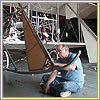

|
|
Greg Cone makes final adjustments to the 1911 Wright Model B just before Ken
Hyde takes the aircraft on its first taxi tests on the grass airfield
surrounding the hangar.
|
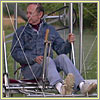

|
|
Ken Hyde takes the controls of the 1911 Model B, its propellers whirring, as
taxi tests begin. A taxi test lets a pilot practice his techniques for taking
directional control of an aircraft on the ground.
|
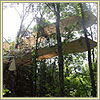

|
|
The taxi test culminates unexpectedly in a rough treetop landing when Ken Hyde
accidentally takes off while trying to avoid a ditch while taxiing. After
flying in circles for ten minutes and trying in vain to put the aircraft down
safely, Hyde was forced to end the flight 30 feet above ground. Though the Model
B was severely damaged (and Hyde sustained a broken wrist), the Wright
Experience team, noting that the Wrights themselves endured their fair share of
crashes, remains determined to repair the Model B and fly another day.
|
|

|

